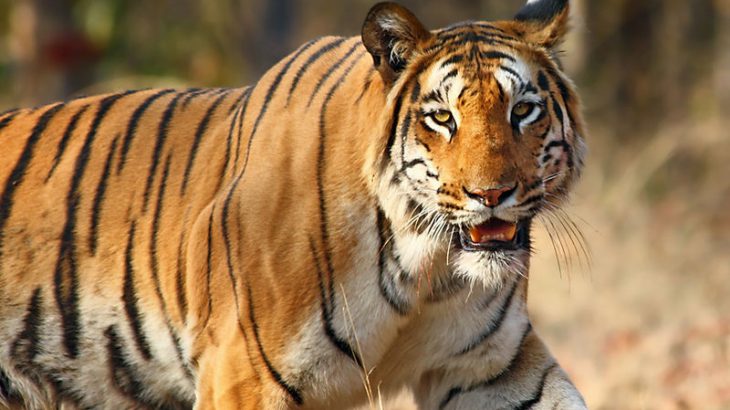The Panna Tiger Reserve (PTR) of India has been an abode for the iconic Tigers for the longest time. This land of dynamic dry deciduous forests are surrounded by the River Ken. Spread over an area of 542.67 square km, it has been declared as the twenty-second Tiger reserve of India and the fifth in Madhya Pradesh. The park along with Ken Gharial Wildlife Sanctuary and surrounding territorial forest area is home to more than 200 species of birds and animals. It is the only large chunk of wildlife habitat remaining in North Madhya Pradesh in the otherwise fragmented forest landscape of the region. Some of the prominent birds found here include the bar-headed goose, honey buzzard, king vulture, blossom-headed parakeet and Indian vulture.
Due to its rich tiger population, PTR held significant importance amongst princely rulers for being a hunting ground. However, this couldn’t continue for long owing to the dramatic loss of tiger population to systematic poaching and other threats. Years after this disappearance, tigers were reintroduced here from neighbouring natural parks at great costs and efforts are still going on to sustain the tiger populations. In fact, as the reserve recuperates from poaching, new threats have again arisen in this territory, the most prominent one being diamond quarrying. A recent report by the Centre for Science and Environment shows that Panna is the only producer of diamonds in the country, accounting for 31.5% of Indian diamond deposits. The Supreme Court of India, by an order passed in 2005, shut down the Majhgaon mines located on the periphery of the park since the mines posed an imminent threat to the vicinity’s biodiversity. But the order only had a little positive outcome, it had no effect on the illegal smuggling and selling of diamonds. Other major threats have been the Ken-Betwa river linkage project and the construction of the Daudham dam to save the drought inflicted areas and provide drinking water to millions of people in the Bundelkhand region.
According to the results of the tiger census declared on July 29, Madhya Pradesh has topped the country with 526 tigers. Additionally, a recent success story resulting from the continued efforts in Panna Tiger Reserve has emerged which highlights an absolute upsurge in the tiger numbers from zero to fifty. The credits for this achievement need to be given to the local community who have initiated the robust process of community ownership of forests to save their lost pride.
This course of saving the tigers was simple and yet comprehensive. It started with devising a strategy for mobilizing the locals who often get detached from their natural habitats – ‘Jan samarthan se baagh samrakshan’ (tiger conservation with people’s support). These people who gave pride and honour utmost position were made to realize the standing of tigers in the sustenance of other ecosystem services. Supplementary factors like the abundant prey base of Chithal, Sambhar, and Neelgai along with the perennial river Ken have also contributed to the revival of this lost species.
The nature camps, started in collaboration with the WWF-India, were a tool to spread knowledge and awareness. These camps gave preference to school children for awareness generation using a mix of indoor as well as outdoor activities like nature games, discussions, presentations, quizzes and two trails in the reserve. To counter the threat of international poaching rackets flourishing under the mercenaries from the local Paridhi, Kanjar and Baheliya tribes, supervisors began handling confrontations with poachers.
Today, PTR’s tigers occupy a range from the Narmada to the Son rivers, having established themselves in the Satpura and Sanjay Tiger Reserves as well.
Subsequently, this increase in the tiger population has made it an interesting tourism site. Expanding tourism is one of the threats of this reserve. Close to 50,000-60,000 people visit PTR now as opposed to 20,000 in the previous years.
The future of the reserve is in the hands of the local Pardhi and Baheliya villagers who are now being trained as guides to control the stresses from tourism. As per K.S. Bhadoriya, PTR’s current active Director, “One member from each village household is a part of one of seven groups, and they take turns to patrol the reserve with the forest personnel.”
The Reserve has been rated “very good” in the four evaluation cycles of the National Tiger Conservation Authority from 2006 to 2018. Such case studies provide meaningful models for future conservation efforts and help us understand how people’s actions and decisions contribute to biodiversity conservation. Different individuals and institutions hold diverse values and priorities and will be convinced to protect or reduce their impact on biodiversity by different arguments. Grow-Trees respects the values and importance held by diverse communities in diverse geographical locations. Based on these values, we mobilize the village panchayats and local communities who are the true owners of forests.
